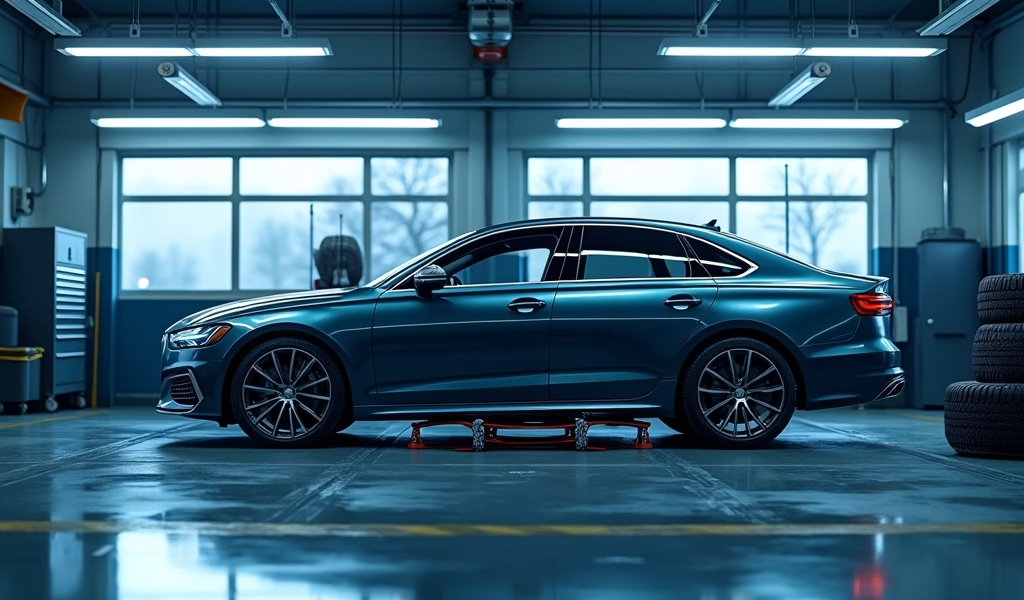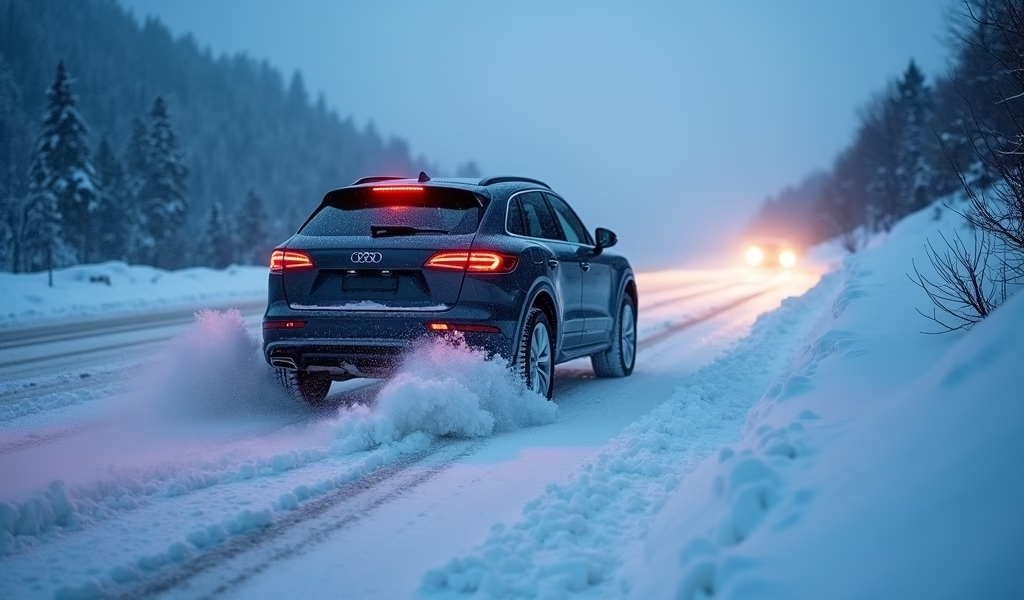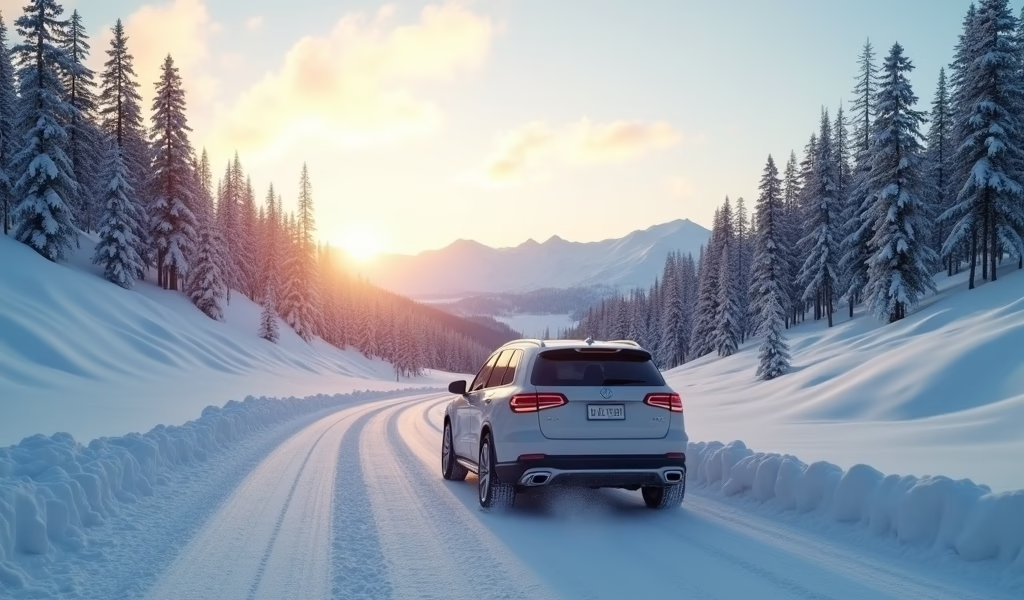Overview
This guide provides essential winter driving strategies including vehicle preparation, driving techniques, and emergency response procedures for snowy conditions. It emphasizes gentle driving inputs, proper tire selection, increased following distances, and specific handling techniques for skids, while highlighting that modern safety technology works best when paired with appropriate driver behavior.
Table of Contents
- Winter Driving Challenges
- Preparing Your Vehicle for Snow
- Snow Driving Techniques
- Handling Skids and Slides
- Navigating Difficult Winter Conditions
- Winter Car Care
- What To Do If You Get Stuck
- Technology That Can Help
- Conclusion
- Frequently Asked Questions
Winter Driving Challenges
When those first snowflakes start falling, even experienced drivers can feel that familiar knot in their stomach. I’ve been working on cars for over 20 years, and I still approach snow-covered roads with healthy respect. Learning how to drive in snow isn’t just a good idea—it’s essential for keeping you, your passengers, and your vehicle safe during the winter months.
Winter driving challenges go far beyond just slippery roads. Your vehicle’s performance changes dramatically as temperatures drop. Cold weather thickens fluids, reduces battery efficiency, and alters tire grip. Visibility drops when snow is falling, and seemingly clear roads can hide patches of treacherous black ice.
The good news? With proper preparation and technique, you can navigate winter roads with confidence. I’ve helped countless drivers master snow driving, and the key is always a combination of vehicle preparation, adjusted driving techniques, and the right mindset. Let’s break down what you need to know to stay safe when the white stuff starts piling up.
Preparing Your Vehicle for Snow
Before that first snowstorm hits, getting your car ready for winter conditions can save you headaches—and potentially dangerous situations—down the road.
Battery Check
Cold weather is brutally hard on batteries. At 0°F, a battery can lose up to 60% of its strength while your engine requires up to twice the normal starting power. If your battery is more than three years old, have it tested before winter arrives. Clean any corrosion from terminals using a mixture of baking soda and water, then rinse and dry thoroughly.
Tire Considerations
Your tires are your lifeline on snowy roads. Consider switching to dedicated winter tires if you live in an area with regular snowfall. Unlike all-seasons, winter tires use special rubber compounds that stay flexible in cold temperatures and feature aggressive tread patterns specifically designed to bite into snow and ice.
If you’re sticking with all-season tires, check your tread depth—you need at least 3/32 of an inch. The old penny test works well: insert a penny with Lincoln’s head upside down into your tread. If you can see the top of his head, it’s time for new tires. Also, proper tire selection for winter conditions can make all the difference between confident driving and white-knuckle terror.
Fluids and Wipers
Make sure your antifreeze is properly mixed (typically a 50/50 ratio with water) and rated for your area’s lowest temperatures. Switch to a winter-grade oil if your owner’s manual recommends it—these flow better in cold temperatures for easier starts.
Fill your windshield washer reservoir with winter-specific fluid rated to at least -20°F. Replace worn wiper blades with winter wipers that have a rubber boot covering the arm assembly to prevent ice buildup. Having clear visibility is non-negotiable for safe winter driving.
Winter Emergency Kit
Pack these essentials in your trunk:
- Folding shovel and ice scraper
- Bag of sand, kitty litter, or traction mats
- Jumper cables or portable jump starter
- Blankets and extra warm clothing
- Non-perishable snacks and water
- Flashlight with extra batteries
- First-aid kit
- Phone charger or power bank
- Reflective triangles or emergency flares
I’ve seen too many drivers stuck in dangerous situations that could have been much less stressful with these basic supplies. A little preparation goes a long way when you’re facing winter emergencies.

Snow Driving Techniques
Driving in snow requires a completely different approach than driving on dry pavement. After decades working with vehicles in all conditions, I can tell you that proper technique matters more than having the fanciest AWD system.
Gentle Does It
The golden rule of snow driving is gentleness. Accelerate gradually to avoid wheel spin. Brake early and with light pressure. Turn the steering wheel smoothly and deliberately. Imagine you’re driving with a hot cup of coffee on the dashboard—any sudden movements will cause a spill.
Start in a higher gear if you have a manual transmission (second gear works well) to reduce torque to the wheels. For automatics, some have a “winter” or “snow” mode that starts in a higher gear—use it if available.
Space and Speed
Triple your normal following distance. On dry roads, the 3-second rule works fine, but in snow, aim for 8-10 seconds minimum. Your stopping distance can increase by 10 times on slippery surfaces, according to NHTSA safety research.
Reduce your speed significantly below the posted limit. Even if you’re driving a vehicle with all-wheel drive capabilities, physics still applies—AWD helps with traction during acceleration but doesn’t help you stop any faster. I’ve seen countless AWD vehicles in ditches because drivers overestimated their stopping ability.
Vision and Planning
Look farther ahead than normal to spot potential hazards early. This gives you more time to react smoothly rather than making sudden maneuvers. Plan your route to avoid steep hills when possible, and try to stick to main roads that are more likely to be plowed and treated.
Watch for telltale signs of icy patches—areas that appear darker and shinier than the rest of the road surface. Be especially cautious on bridges and overpasses, which freeze before regular road surfaces due to cold air flowing both above and below the pavement.
Handling Skids and Slides
Even with perfect preparation and careful driving, skids can happen. How you react in those first seconds makes all the difference between a minor scare and a serious accident.
Front-Wheel Skids (Understeer)
If your front wheels lose traction during a turn, your car will continue straight despite turning the wheel—this is called understeer. When this happens:
- Ease off the accelerator (don’t brake)
- Straighten the steering wheel slightly until you feel traction return
- Look and steer gently in your intended direction
The natural instinct to turn the wheel more sharply is exactly wrong and will worsen the skid. I’ve taught this technique to hundreds of drivers, and it feels counterintuitive until you practice it.
Rear-Wheel Skids (Oversteer)
When your car’s rear end starts sliding out (oversteer), it can be alarming, but stay calm and:
- Steer in the direction of the skid (if the rear slides right, steer right)
- Avoid braking or accelerating suddenly
- Keep your eyes focused where you want to go, not on the obstacle you’re trying to avoid
Modern vehicles equipped with anti-lock braking systems can help prevent skids during braking, but they can’t overcome physics. If you feel the ABS activate (a pulsing in the brake pedal), maintain steady pressure and continue steering.
All-Wheel Drive Considerations
AWD vehicles behave differently in snow, providing better acceleration but sometimes masking how slippery conditions actually are. Remember that AWD helps you go, not stop. I’ve seen too many overconfident AWD drivers end up in ditches because they were traveling too fast for conditions.
Navigating Difficult Winter Conditions
Some winter driving scenarios require specific approaches beyond general snow driving techniques.
Hills and Inclines
Hills require strategy in winter conditions. For uphill climbs, build gentle momentum on flat ground before reaching the hill. Use steady, light throttle while climbing, and avoid stopping if possible. Once you lose momentum on an icy hill, regaining it can be extremely difficult.
When descending, slow down before starting the downhill section. Shift to a lower gear to let engine braking help control your speed. Apply brakes gently and intermittently rather than holding them continuously, which can lead to loss of control.
Black Ice
Black ice is perhaps winter’s most dangerous hazard because it’s nearly invisible. Watch for pavement that looks wet but has no spray or splashing from other vehicles. Areas that remain shaded during the day are particularly prone to ice formation.
If you encounter black ice, avoid sudden movements. Take your foot off the accelerator and keep the steering wheel straight until you’ve passed over the icy section. If you start to skid, follow the techniques discussed earlier.
Whiteout Conditions
In heavy snowfall that severely limits visibility:
- Reduce speed dramatically
- Use low-beam headlights (high beams reflect off snow particles and worsen visibility)
- Use the right edge of the road or lane markings as a guide
- Consider finding a safe place to pull completely off the road if conditions become too dangerous
According to National Weather Service guidelines, drivers should avoid travel entirely during severe winter weather warnings whenever possible. Sometimes the best winter driving technique is choosing not to drive at all.

Winter Car Care
Keeping your vehicle in top condition during winter isn’t just about performance—it’s about preventing long-term damage from winter’s harsh elements.
Fighting Road Salt Damage
Road salt is a double-edged sword—it helps melt ice on roads but wreaks havoc on your vehicle. Salt accelerates rust and corrosion, particularly on your undercarriage, brake lines, and exhaust components.
Wash your car frequently during winter, ideally on days when temperatures rise above freezing. Pay for the undercarriage wash option, or if washing at home, use a sprinkler attachment to spray underneath your vehicle. This small investment prevents costly rust repairs later.
Protecting Exterior and Interior
Apply a quality wax before winter arrives to provide a protective barrier for your paint. Consider a silicone spray for door seals and weatherstripping to prevent freezing shut. Place rubber floor mats in your vehicle to protect carpeting from salt and slush that gets tracked in.
Don’t forget to clear snow completely from your vehicle before driving—not just for visibility but because snow flying off your car creates hazards for other drivers and can result in tickets in many states. A telescoping snow brush with ice scraper is worth its weight in gold on snowy mornings.
Fuel and Fluids
Keep your fuel tank at least half-full during winter. This reduces condensation in the tank that can lead to fuel line freeze-ups and provides reserve fuel if you become stranded. Consider using a fuel additive designed to prevent fuel line freezing if temperatures in your area regularly drop below 0°F.
Check all fluid levels more frequently in winter, as cold weather operation can increase consumption of some fluids. This is especially true for windshield washer fluid, which gets heavy use during slushy conditions.
What To Do If You Get Stuck
Even the most prepared drivers occasionally get stuck in snow. Knowing how to handle it can make the difference between a minor delay and an emergency situation.
Self-Recovery Techniques
If your vehicle becomes stuck:
- Stay calm and assess the situation
- Clear snow from around tires, under the vehicle, and from the exhaust pipe
- Straighten wheels and try to rock back and forth (drive to reverse, reverse to drive) using gentle acceleration
- Place sand, cat litter, or floor mats in front of the drive wheels
- Try starting in second gear to reduce wheel spin
Sometimes temporarily turning off traction control can help when you need controlled wheel spin to climb out of deep snow. Just remember to turn it back on once you’re free.
When to Call for Help
Know when your situation requires professional assistance:
- Vehicle is tilted at an angle or high-centered on snow
- Wheels are spinning with no progress after multiple attempts
- Vehicle has slid off the road entirely
- You feel unsafe attempting self-recovery
In my years as a mechanic, I’ve seen too many minor situations turn into major problems because drivers damaged their vehicles attempting increasingly desperate self-recovery methods. When in doubt, call for help.
Staying Safe While Waiting
If you must wait for assistance:
- Stay with your vehicle unless safety is an immediate concern
- Run the engine for about 10 minutes each hour for heat (ensure exhaust pipe is clear of snow)
- Crack a window slightly to prevent carbon monoxide buildup
- Use emergency flashers or tie a brightly colored cloth to your antenna
- Conserve phone battery by making necessary calls, then powering down
Your winter emergency kit will be invaluable in this situation. Stay warm, stay visible, and stay patient.
Technology That Can Help
Modern vehicles come equipped with technologies specifically designed to help in winter conditions, while smartphone apps can provide crucial information for safer winter journeys.
Vehicle Safety Systems
These systems can significantly improve winter driving safety:
- Electronic Stability Control (ESC) helps maintain directional control during skids
- Traction Control Systems (TCS) reduce wheel spin during acceleration
- Anti-lock Braking Systems (ABS) prevent wheel lockup during braking
- Hill Descent Control maintains safe speeds on slippery downhill sections
While these technologies provide valuable assistance, they work best when paired with appropriate winter driving techniques. They can’t overcome physics or replace driver judgment.
Weather and Navigation Apps
Technology extends beyond your vehicle:
- Weather apps with hourly forecasts and radar for your route
- Navigation apps with real-time traffic data to help avoid weather-related incidents
- Road condition alerts from state transportation departments
Planning around winter weather, rather than driving through it, is often the safest choice. Many weather-related accidents could be avoided entirely with better timing and route planning.
Remote Start Benefits
Remote start systems aren’t just about comfort—they improve winter safety by allowing engines to reach operating temperature, improving performance and defrosting windows before you enter the vehicle. This enhances visibility and reduces the need for bulky clothing that can restrict movement while driving.
Just remember that an idling vehicle should never be left unattended in public places, both for security reasons and because it’s illegal in many jurisdictions.
Conclusion
Winter driving doesn’t have to be a white-knuckle experience. With proper vehicle preparation, adjusted driving techniques, and the right mindset, you can navigate snow-covered roads safely and confidently. Remember that the best winter drivers aren’t those with the fastest vehicles or most advanced driving systems—they’re the ones who understand and respect winter conditions.
The most important winter driving skill might be knowing when not to drive at all. No appointment or errand is worth risking safety when conditions are truly dangerous. Sometimes the best decision is to stay put and wait for conditions to improve.
I’ve spent decades helping drivers prepare for and navigate winter roads, and I can tell you that patience and preparation are your best allies when the snow starts flying. Take your time, give other drivers space, and remember that getting there safely is always more important than getting there quickly.
Stay warm, stay safe, and enjoy the unique beauty of winter—preferably through a properly defrosted windshield!
Frequently Asked Questions
Should I warm up my car before driving in cold weather?
Modern vehicles only need about 30 seconds of warm-up time before driving gently. Extended idling wastes fuel and increases engine wear compared to driving gently after a brief warm-up.
Is all-wheel drive or four-wheel drive better for snow?
Both systems provide better traction for acceleration in snow, but neither improves braking performance. The best setup combines AWD/4WD with winter tires for maximum winter capability.
What should I do if my car starts sliding on ice?
Don’t panic or brake suddenly. Look and steer in the direction you want to go, ease off the accelerator, and make smooth, gentle corrections.
Are winter tires really necessary if I have all-season tires?
In areas with regular snow and temperatures consistently below 45°F, winter tires provide significantly better traction, braking, and handling. All-season tires compromise performance in extreme conditions.
What’s the safest speed for driving in snow?
There’s no single safe speed as it depends on conditions, visibility, and your vehicle. Generally, reduce speed by at least 25-50% below posted limits and adjust based on actual road conditions.


Pingback: Driving in the Snow: 5 Car Care Secrets - knowsyourcar.com